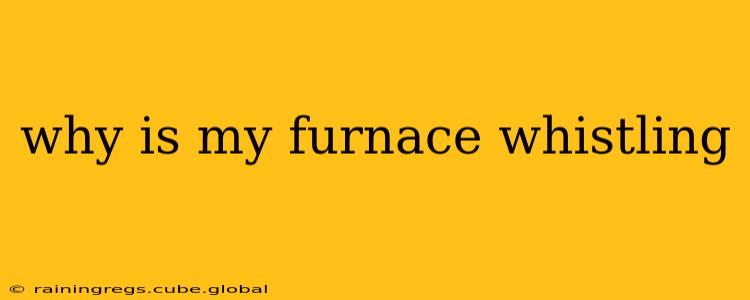A whistling furnace can be a frustrating and concerning sound. It often indicates a problem that needs addressing, potentially impacting your heating system's efficiency and even safety. This guide will explore common causes of furnace whistling, offering troubleshooting tips and potential solutions. Ignoring a whistling furnace can lead to larger, more expensive repairs down the line, so understanding the source of the noise is crucial.
What are the common causes of a whistling furnace?
Several factors can contribute to a whistling sound emanating from your furnace. Let's examine the most frequent culprits:
1. Loose or Damaged Components:
This is often the simplest and most easily solved cause. A loose panel, screw, or other internal component can vibrate and create a whistling sound as air moves through the system. Check all access panels and screws to ensure they are securely fastened. Pay close attention to the blower motor and its housing.
2. Problems with the Blower Motor:
The blower motor is responsible for circulating heated air throughout your home. Worn bearings within the motor can produce a high-pitched whistling sound. This is a more serious issue that usually requires professional attention as the motor might need replacement or lubrication.
3. Issues with the Air Filter:
A clogged or dirty air filter restricts airflow, forcing air to squeeze through smaller openings at higher speeds. This can create a whistling or hissing sound. Replacing the air filter with a new, clean one is a quick and inexpensive fix that should resolve the problem if this is the cause. Remember to check your filter regularly – ideally every 1-3 months, or more frequently if you have pets or allergies.
4. Problems with the Heat Exchanger:
The heat exchanger is a crucial part of your furnace responsible for transferring heat from the combustion process to the air. Cracks or leaks in the heat exchanger can create a whistling or hissing sound. This is a serious safety concern, as it can lead to carbon monoxide leaks. Never attempt to repair a damaged heat exchanger yourself. Contact a qualified HVAC technician immediately if you suspect a problem with the heat exchanger.
5. Ductwork Issues:
Air leaks or restricted airflow within your ductwork can also cause whistling sounds. These leaks can occur at joints or connections within the duct system. A professional HVAC technician can inspect and seal any leaks to improve airflow and eliminate the whistling.
6. Gas Leaks:
While less common, a gas leak within the furnace can sometimes produce a high-pitched whistling sound. This is a very serious safety hazard. If you suspect a gas leak, immediately turn off your furnace, leave your home, and contact your gas company or emergency services.
How can I troubleshoot my whistling furnace?
- Check the obvious: Start by examining the easily accessible components, such as the air filter and access panels, ensuring everything is securely fastened.
- Listen carefully: Try to pinpoint the location of the whistling sound within the furnace. This can help you narrow down the potential cause.
- Check the air filter: Replacing a dirty air filter is a quick, low-cost solution that often fixes the problem.
- Contact a professional: If the whistling persists after checking the simple solutions, or if you suspect a more serious problem like a cracked heat exchanger or gas leak, contact a qualified HVAC technician immediately. Do not attempt to repair the furnace yourself unless you have the proper training and experience.
Remember, safety should always be your top priority. If you smell gas, or if the whistling is accompanied by other unusual sounds or smells, immediately turn off your furnace and contact a professional.
This article provides general information and should not be considered professional advice. Always consult with a qualified HVAC technician for diagnosis and repair of your furnace.
